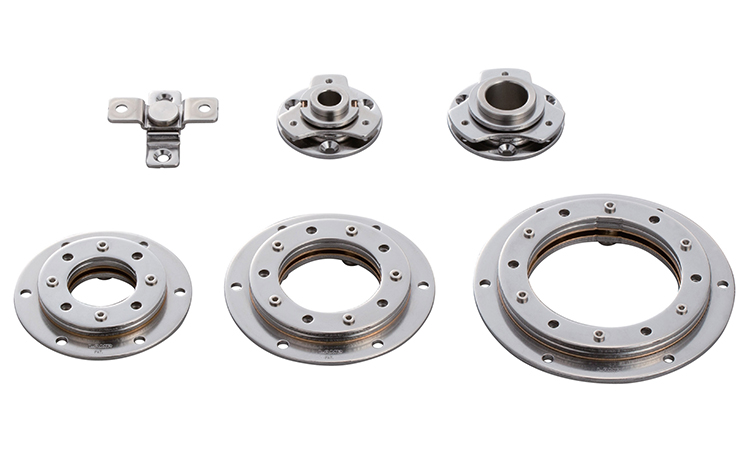Sugatsune introduces Swivel Torque Hinge HG-S for smooth…

Manufacturing Sector Growth | Indian Manufacturing|manufacturing Update
Indian manufacturing sector has emerged as a major growth sector for the Indian economy. Driven by the government’s push and rising domestic consumption, the sector is slated to continue its growth momentum. As Engineering Review celebrates its 18th anniversary, we take a look at the opportunities and challenges in Indian manufacturing industry and its key segments
Deepa Banka, Director,
Novoflex Industries Pvt.Ltd
Backed by the government’s initiatives, such as Make in India and sector specific policies and incentives, Indian manufacturing industry has been on a high growth trajectory. The industry is slated to continue its good run and solidify its position as one of the high growth sectors in India. According to a study by Deloitte, India is expected to jump six ranks to No. 5 in the 2020 Predicted Manufacturing Competitiveness. In the recent years, manufacturing industry in the country has been witnessing a shift in the ecosystem. In the past, textiles, gems and jewelry dominated the industry. However, today auto components, electronics, engineering good, chemical and pharma are at the forefront. Both domestic and foreign investments in the Indian manufacturing sector have been on the rise attracted by India’s huge market opportunity of more than a billion consumers and increasing purchasing power. Many global giants, including Apple, Samsung, GE, Boeing, to name a few, have either set up or are planning to set up their manufacturing units locally. Given the positive sentiment around manufacturing, the sector has been at the forefront in creating jobs and has continued to be one of the growth drivers in India. The government is committed to keep up the momentum and establish India as a global manufacturing powerhouse with its ambitious targets of increasing manufacturing’s share to the country’s GDP to 25% by 2022 from 16% and to create 100 million jobs by 2022.

Mr. Vineet Seth, Managing Director – South Asia & Middle East, Mastercam APAC.
Right from a large pool of engineers, a young and low-cost labour force and a significant domestic consumption of manufactured goods, India has several factors that work in its favour and can help it emerge as a manufacturing powerhouse. Introduction of GST, which has helped in removing internal barriers, has also added to India’s strengths. Due to these sustained business reforms and policies, India has moved to the 100th spot in the World Bank’s Ease of Doing Business global rankings. That said, there are some challenges that the country needs to overcome in order to attain its vision of being the global hub of manufacturing. Firstly, the issue of labour shortage is looming large over Indian manufacturing industry. The need of the hour currently for the country is to skill, reskill and upskill the working population. Initiatives such as Skill India is thus integral to the growth of manufacturing in India as it will ensure a steady supply of workforce for enhanced productivity and growth. Also, productivity of workers in India is significantly lower as compared to its peers. As per a report by McKinsey, workers in India’s manufacturing sector are almost four and five times less productive than their counterparts in Thailand and China, respectively. This is primarily because of the fact that India lags behind in critical areas, such as production planning, supply chain management and quality. Low power availability is also another key issue facing the Indian manufacturing industry, which results in reduced productivity and efficiency. For fulfilling the promise of India’s manufacturing sector, these issues need to be addressed. The outlook for the industry looks upbeat. As per McKinsey’s analysis, rising demand in India, together with the multinationals’ desire to diversify their production to include low-cost plants in countries other than China, could together help India’s manufacturing sector to grow six-fold by 2025, to $1 trillion. This will create up to 90 million domestic jobs.
We, at Engineering Review, closely analyze the key segments of the manufacturing industry and their individual opportunities and challenges that could impact the overall development of the sector and promote advanced practices in manufacturing.
Power Industry: Key Pillar of Manufacturing
Being one of the most critical components of infrastructure, power is integral to the growth of a nation. Indian power sector is undergoing a significant change with the demand seeing constant uptick, backed by increased manufacturing activity. Sustained economic development will continue to increase electricity demand in the country in the coming years. Speaking about the changes emerging in the power sector, Deepa Banka, Director, Novoflex Industries Pvt.Ltd says, “In the past 15 years, power consumption has increased rapidly and is expected to grow exponentially far outpacing the current capacity within the next 5 years. With electrification reaching 100% of the villages in India, this is just the tip of the iceberg. With more modernisation comes an innate need of power capacity to sustain lifestyles. Household kitchens are being electrified everyday with the adaptation of induction plates and cookware; transport systems are moving to all electric modes; IoT connects all future ready devices to each other and are online throughout their lifetime; the possibilities and applications are endless.”

Mr.Guruprasad Rao,
Director & Mentor, Imaginarium India
Favorable government policies are giving a further boost to the segment. For instance, ‘Power for all’ is the right step in the direction to accelerate capacity addition. India’s power sector is extremely diversified with sources of generation ranging from conventional sources such as coal, lignite, natural gas, oil, hydro and nuclear power to viable non-conventional sources such as wind, solar, and agricultural and domestic waste. However, the focus is now more on the renewable power segment. The government has released its roadmap to achieve 175 GW capacity in renewable energy by 2022, which includes 100 GW of solar power and 60 GW of wind power. Looking ahead, the outlook for the sector looks extremely positive and the sector is expected to attract investments worth Rs 11.56 trillion between 2017 and 2022 in thermal, hydro, nuclear and renewable segments.
Machine Tools: Poised for Rapid Growth
Being the mother industry for manufacturing, machine tools sector’s growth is closely linked to the future strength and capability of Indian manufacturing industry. In the past few years, machine tools sector has been gaining significant traction backed by the government’s focus on the manufacturing sector. As per industry reports, the industry is projected to grow at 5.5% annually through 2019. “The Indian Machine Tools Industry is estimated to have an annual turnover of a little over Rs 7,000 crore, according to IMTMA’s recent annual report, with a growth of around 26% over last year. These numbers are very encouraging and I’m positive that we are yet to go higher to hit the peak. Domestic consumption is at least twice as much, and we can gauge that imports account for at least 50% or more – considering that we also export machine tools from India,” shares Vineet Seth, Managing Director – South Asia & Middle East, Mastercam APAC.

Mr. Ram Grover,
Managing Director,
Elesa and Ganter India
While the industry is on growth path, India as a brand is yet to make a mark in the global market. It faces stiff competition from countries like China and Taiwan in terms of pricings and countries like Japan and Germany in terms of technology. Sharing his views on the evolving landscape, Guruprasad Rao, Director & Mentor, Imaginarium India says, “Unlike Indian IT which grew into world’s mighty force, Machine tools somewhere lost the race initially to the innovative West and Japan. The economy was controlled by OEMs with their know-how monopoly. Thanks to subsequent economic reforms, today we have a decent growth in machine tool industry.”
Indian machine tool industry is now maturing and has started adapting new and innovative technologies to meet the demand of user industries for automation and increase in productivity. There is a huge demand for reduced manual intervention in process control using machine tool control system in a bid to optimize cost and increase production and uniformity. Machine Tool industry is also evaluating advanced technologies, such as Industry 4.0. Currently, only large and mid-sized players in India are showing inclination to adopt these technologies, given the cost. However, as the awareness around Industry 4.0 increases and successful use cases come to light, it is slated to emerge as a big trend that will drive and shape the future of Indian machine tools industry. “The industry is now working towards developing new technologies and bridging the technology gap which existed earlier. One important factor which has provided substantial stimulus to the Machine Tool industry is the rapid growth of exports. With this the need for adopting better technologies, materials and machinery to deliver international quality has become very important for Indian businesses,” says Ram Grover, Managing Director, Elesa and Ganter India. Sharing his views on increased thrust on Industry 4.0, Mr. Vijay Zaritaklikar, National Sales Manager, UCAM Pvt. Ltd., says, “Industry 4.0 and smart manufacturing have already created a buzz in the machine tool world and many of the manufacturing companies including us have started initiatives towards it. We have introduced various methods and strategies in our manufacturing facility so as to manufacture rotary tables in a cost effective way and of higher quality. We have developed Single Axis Controller that can be connected with wi-fi and also our Noah Series Gear Hobbing Machine’s CNC Controller is also equipped with wi-fi making it more user friendly.” The outlook for the Indian machine tools industry looks positive in the years to come. As Indian machine tools industry focuses on developing specialized, niche tools for empowering high-end manufacturing sectors, it can enter an era of significant growth.

Mr. Vijay Zaritaklikar,
National Sales Manager, UCAM Pvt. Ltd
Automation: Driving the next phase of growth in manufacturing
Industrial automation is one of the key pillars in India’s vision of becoming a global manufacturing powerhouse. Automation is crucial for the Indian manufacturing industry to be digitally transformed and be future ready to manage the fast changing business and technology landscape.
Commenting on the current landscape of Automation industry, Santosh Tatte, Country Manager, HMS Industrial Networks India says, “Indian Industrial Automation industry is very diversified. Indian industrial automation is sectored differently which majorly includes types of automation, automation technologies, and end-users. There are companies that are dealing in new machine automation, projects, plants. But there are others who specialize in retrofitting or plant upgradation and modernization. So, although Indian Automation Industry is very competitive, there is space for everyone. There are many global industries setting up their operation in India. The Indian Automation industries are developing their automation competences trying to meet the global standards and to meet the pressing demand for the operation excellence, developed output, quality etc. Industrial automation field usage devices like PLC / DCS / Controllers / HMI / SCADA to product Intelligent and Smart machines to automate the various industrial procedures and to decrease human interference.”

Mr. Santosh Tatte,
Country Manager,
HMS Industrial Networks India
The key reason automation is gaining traction is that it makes manufacturing processes more efficient and reduces inconsistencies and defect rates. “Indian Automation Industry is helping manufacturing setups to get repeatability, improve productivity, efficiency, safety and manage dependability all through the manufacturing procedures and processes around the industries,” asserts Tatte. The Industrial Automation market is booming on account of growing requirement to meet global quality standards, achieve zero defects and make manufacturing processes more efficient. Further, favorable government policies are giving a further boost to the segment. Rise in demand and increasing buying power will continue to drive growth in the Industrial Automation sector.
Considering the current situation, it is expected that the market for industrial automation in India will increase more significantly over the decades. “India, as a growing economy, is anticipated to grow its manufacturing sector by 25%-30% by FY2030. Based on the forecast period of 2017-2023, the Industrial Automation Market in India will observe a significant CAGR of 11.6%,” shares Tatte.









